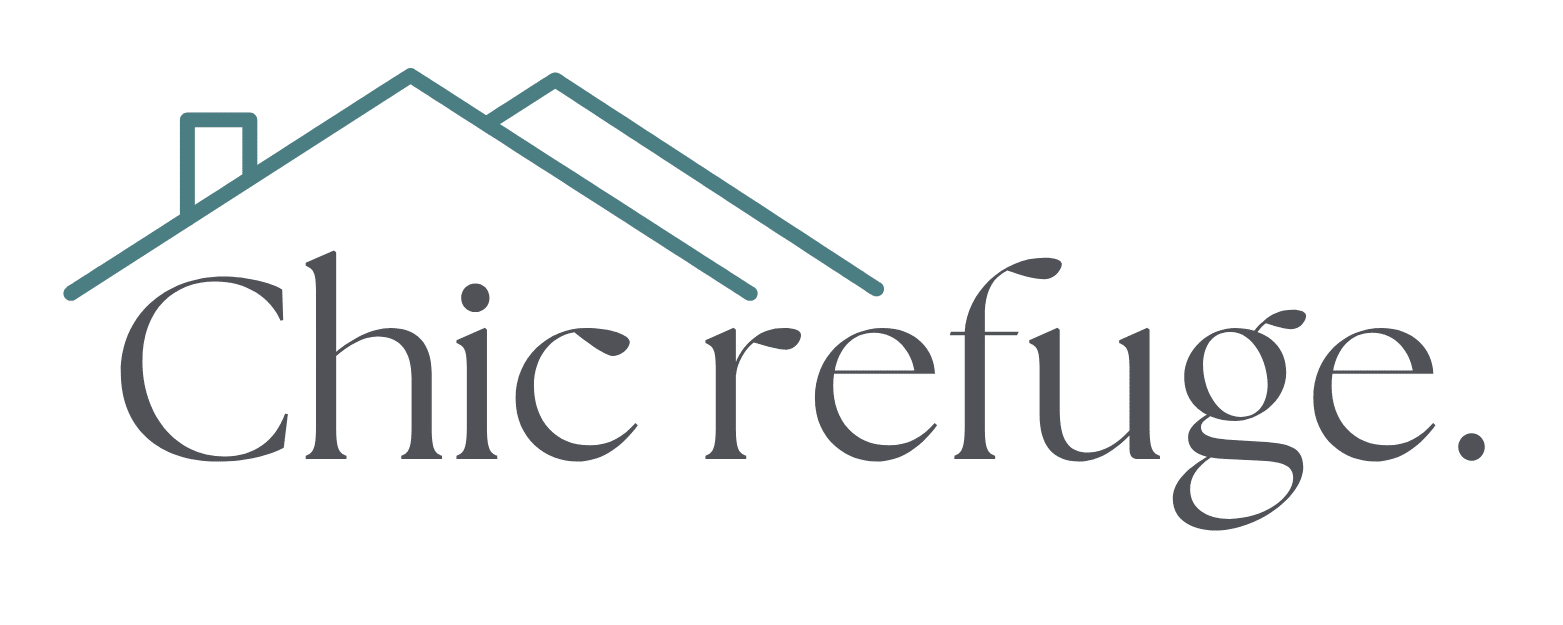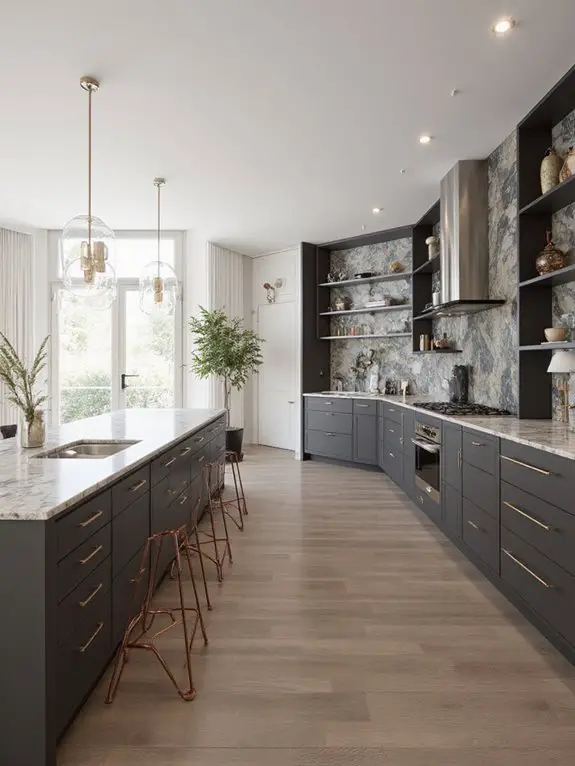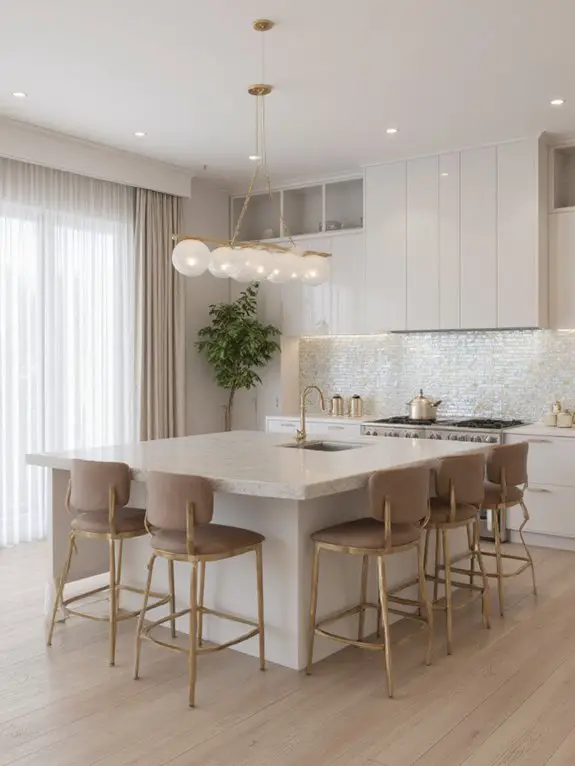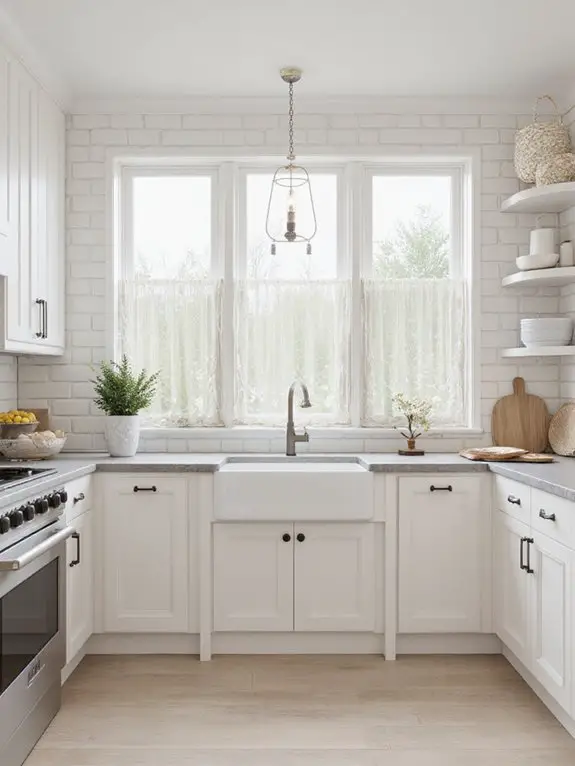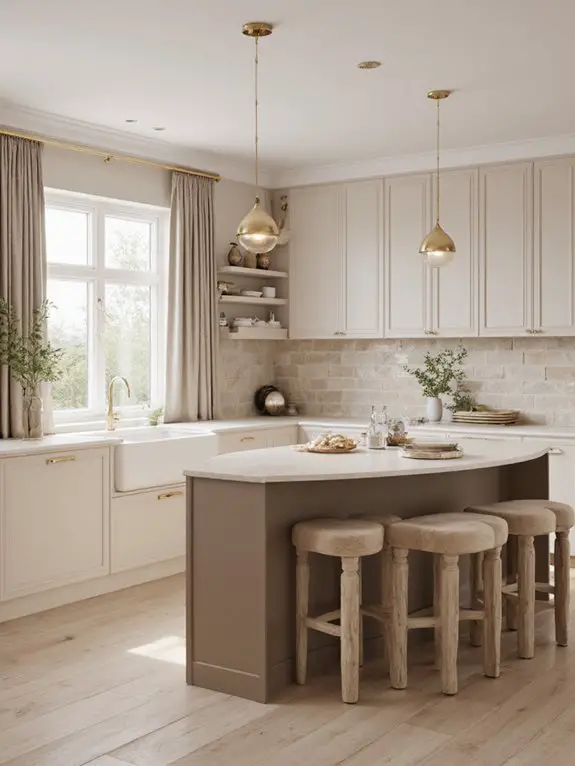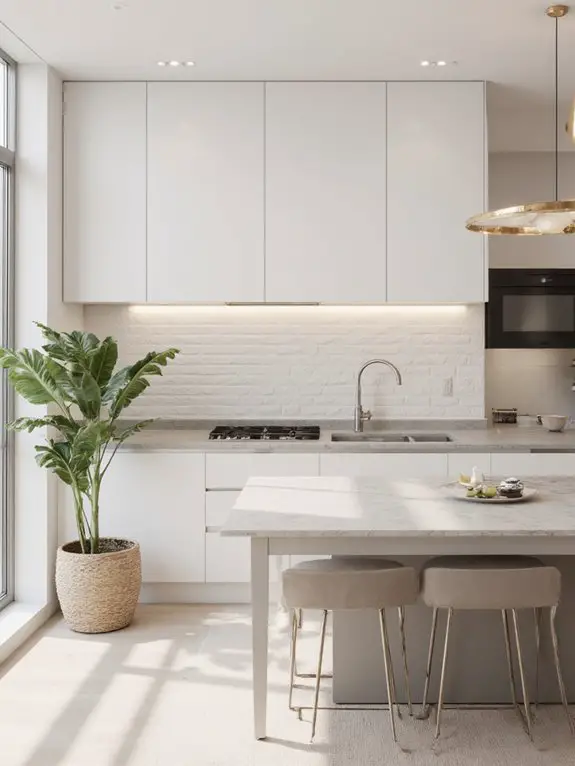I’ve explored unique kitchen ideas that combine bold creativity with practicality. Try vibrant backsplashes or leather panels for texture, and experiment with unexpected materials like reclaimed wood or copper. Open shelving displays curated items while geometric tiles add modern flair. Statement lighting, like bold pendants or industrial sconces, enhances ambiance. Mix metals for contrast and incorporate warm wood tones for balance. These thoughtful touches can transform your kitchen into a functional, stylish space. Discover even more inspiring tips ahead.
Bold Color Accents
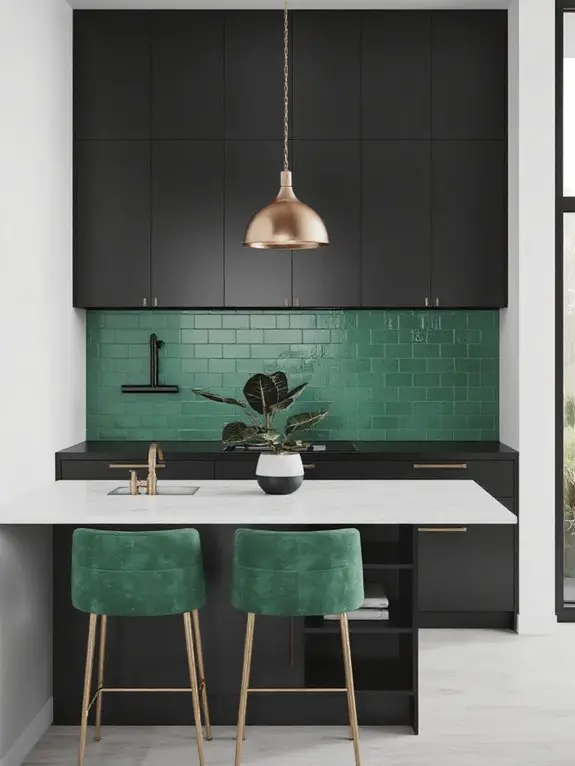
When I’m looking to refresh my kitchen, I often turn to bold color accents because they instantly add personality without a full renovation. I’ll paint a single wall in a vibrant hue like teal or mustard yellow to create a focal point.
Adding colorful cabinet hardware, like brass pulls or cobalt knobs, can also elevate the space. I’ll swap out neutral dishware for bold, patterned pieces that pop on open shelves or countertops.
Even small touches, like a bright runner or a set of colorful bar stools, can make a big impact. It’s an easy way to infuse energy and style.
Open Shelving Displays
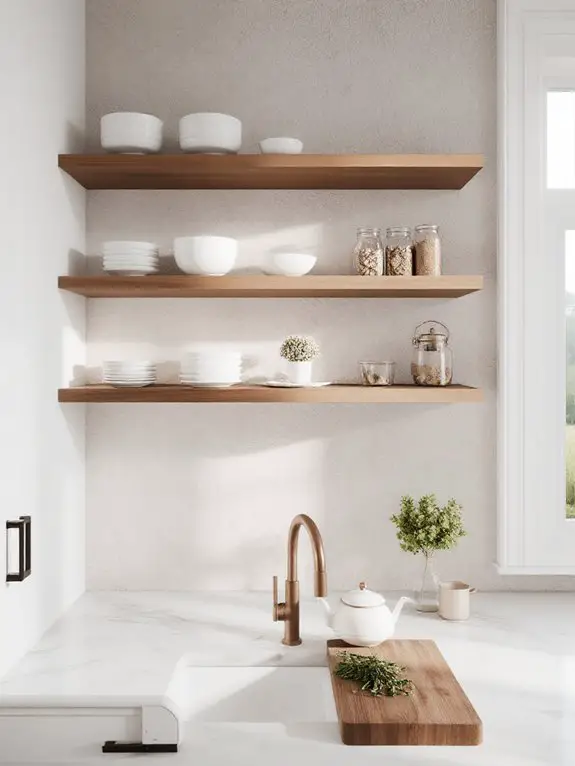
If I want to create a sense of openness and accessibility in my kitchen, open shelving displays are a go-to solution. They eliminate bulky cabinets, making the space feel larger while putting everyday items within easy reach.
I’ll choose sturdy materials like reclaimed wood or metal for durability, and I’ll keep the arrangement tidy—grouping items by use or color for visual appeal.
Mixing practical pieces like dishes with decorative accents adds personality, but I’ll avoid overcrowding to maintain a clean look.
Open shelves also encourage me to curate my collections, turning functional storage into a stylish focal point.
Statement Lighting Fixtures
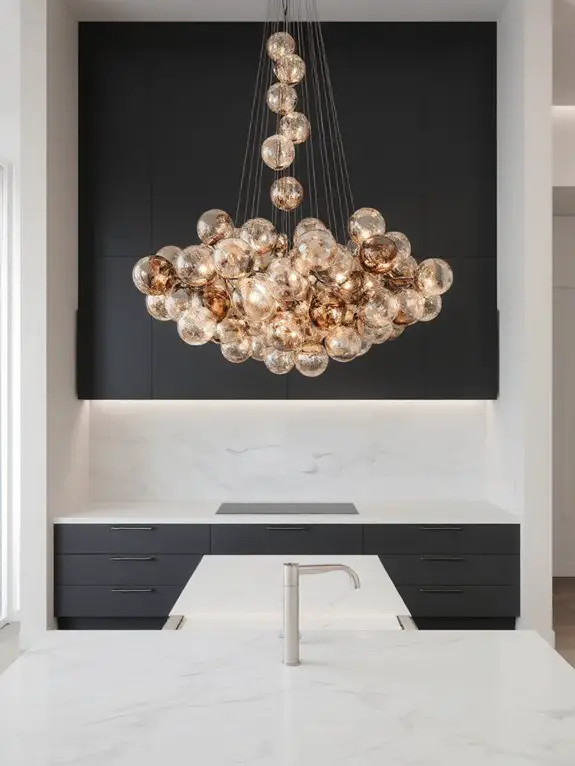
To elevate the design of my kitchen, I’ll incorporate statement lighting fixtures that not only illuminate the space but also serve as a striking focal point. I’ll choose pieces that reflect my personal style, whether it’s bold geometric pendants, a chic chandelier, or industrial-inspired sconces.
I’ll consider scale, ensuring the fixture complements the room’s proportions without overwhelming it. Positioning is key—I’ll hang pendants over an island or dining area to draw the eye upward. Opting for dimmable options will allow me to adjust the ambiance.
With the right fixture, my kitchen will feel both functional and visually mesmerizing.
Unexpected Backsplash Materials
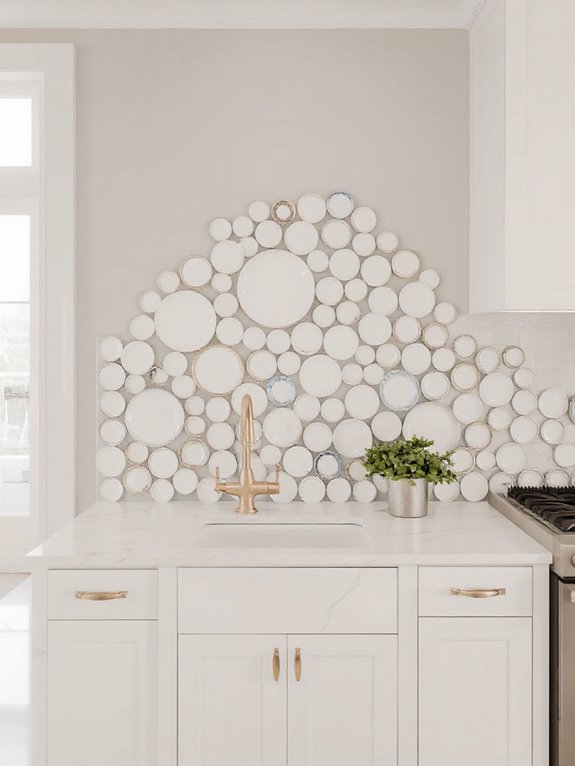
While traditional tile backsplashes are a safe choice, I’m exploring unexpected materials to add a unique, personalized touch to my kitchen. Leather panels, for instance, create a warm, textural contrast that’s both rustic and modern.
Glass sheets, etched or tinted, bring a sleek, reflective quality that brightens the space. Reclaimed wood adds character and sustainability, though it requires proper sealing for durability.
Metal sheets, like brushed stainless steel or copper, offer an industrial edge that’s easy to clean. Even chalkboard paint can be a fun, functional option for jotting down recipes. These materials push boundaries while maintaining practicality.
Mixed Metal Finishes
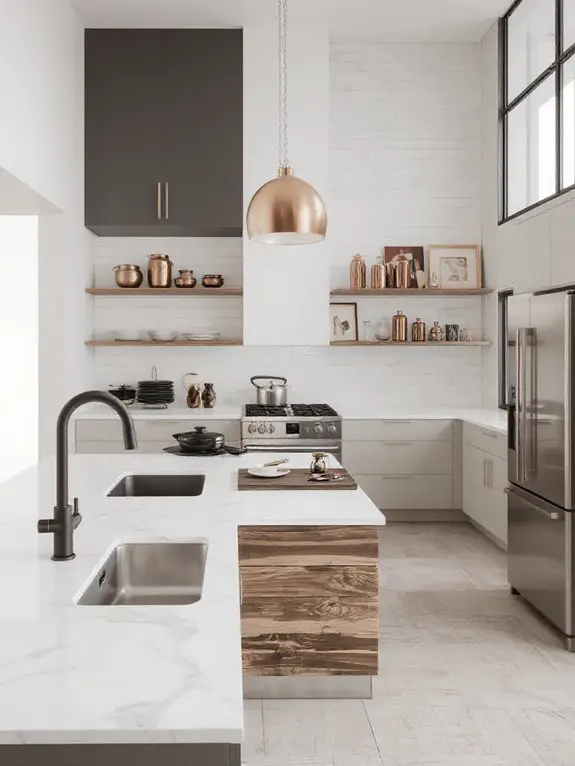
Moving from unexpected backsplash materials, I’ve also been experimenting with mixed metal finishes to elevate my kitchen’s design. Combining metals like brass, stainless steel, and matte black creates a layered, dynamic look that avoids monotony.
I started by selecting one dominant metal, like brushed nickel for fixtures, then introduced accents, such as copper handles or gold light fixtures. The key is balance—I make certain no single metal overwhelms the space.
Textural contrasts, like polished and brushed finishes, add depth. Mixed metals work best when tied together through repeated elements, like a brass faucet paired with brass cabinet pulls. It’s a subtle yet impactful upgrade.
Two-Tone Cabinetry
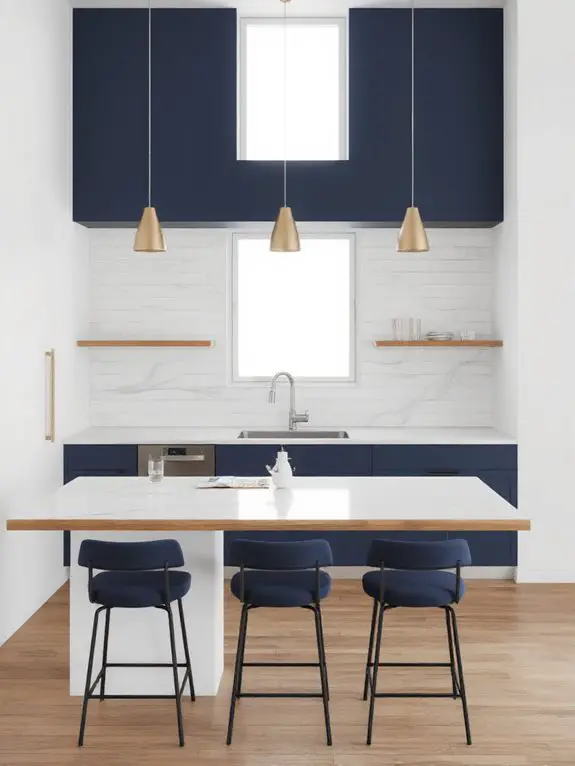
Experimenting with two-tone cabinetry has allowed me to introduce contrast and depth into my kitchen design without overwhelming the space. I’ve found that pairing lighter upper cabinets with darker lower ones creates a balanced visual flow while keeping the room airy.
Neutral tones like white and gray work well for versatility, but I’ve also loved bold combinations like navy and gold for a modern twist. Materials matter—mixing wood with painted finishes adds texture.
Keep hardware consistent to unify the look. It’s a simple yet impactful way to personalize your kitchen while maintaining harmony in the overall design.
Hidden Storage Solutions
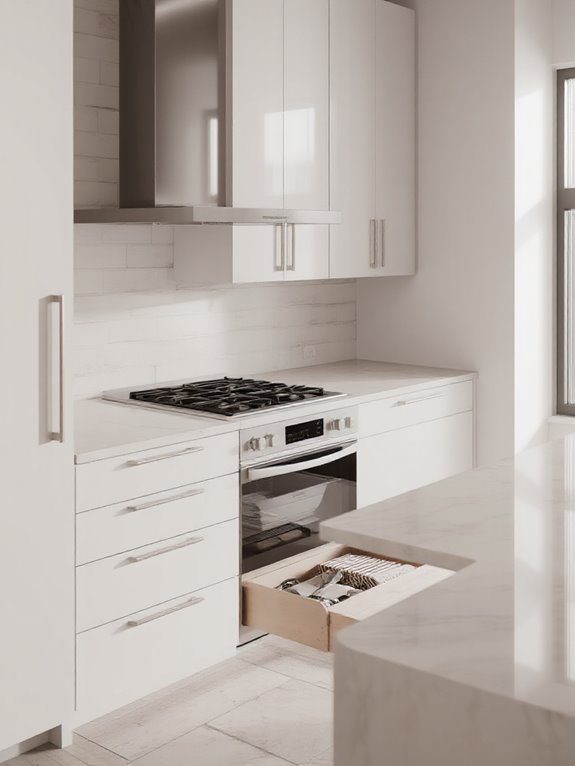
To maximize both functionality and aesthetics, I’ve embraced hidden storage solutions as a game-changer in kitchen design. I’ve found that incorporating pull-out drawers inside cabinets, toe-kick storage under base cabinets, and built-in spice racks behind cabinet doors keeps clutter out of sight.
Vertical dividers for baking sheets and cutting boards inside deep cabinets are another smart addition. I also love using appliances like pop-up mixers or fold-down tables that tuck away when not in use.
Roll-out pantry shelves and corner cabinet carousels make every inch accessible. These solutions streamline my kitchen while maintaining a clean, uncluttered look.
Vintage-Inspired Appliances
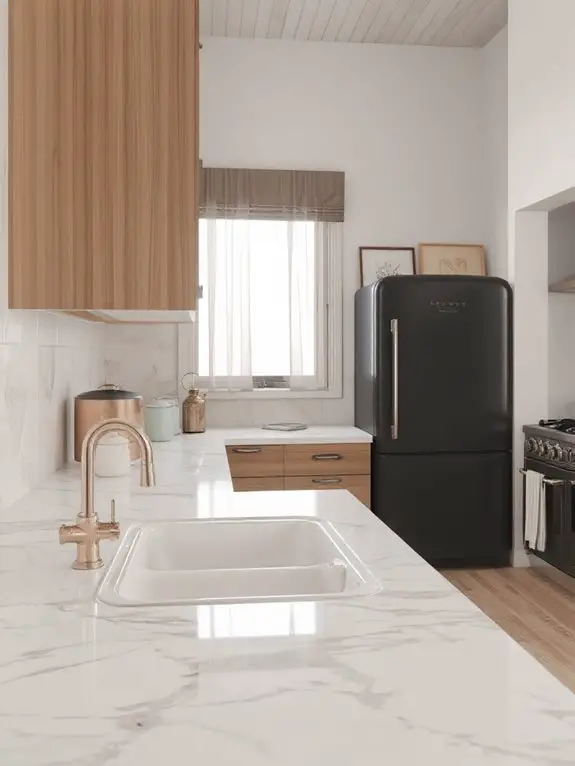
While modern appliances offer advanced functionality, I’ve found that vintage-inspired appliances can bring a timeless charm and character to the kitchen without sacrificing practicality. Retro-style refrigerators, stoves, and dishwashers often feature bold colors, polished finishes, and classic designs that evoke mid-century aesthetics.
These appliances are typically built with modern technology, ensuring energy efficiency and reliability. I recommend choosing pieces that balance authenticity with usability, like a vintage-inspired range with intuitive controls or a fridge with ample storage.
Pairing these appliances with neutral tones or industrial elements can create a cohesive look. They’re a perfect way to blend nostalgia with modern convenience.
Countertop Extensions
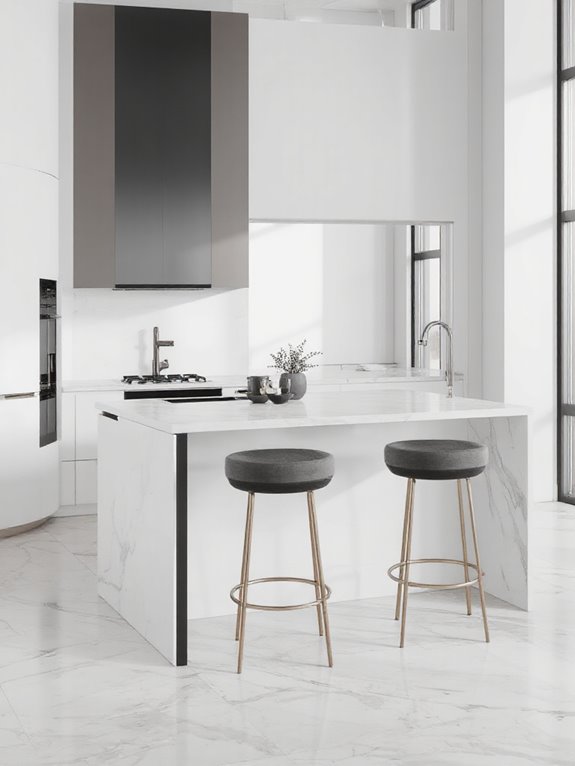
Countertop extensions can transform your kitchen’s functionality by maximizing workspace and streamlining meal preparation. I’ve found they’re perfect for creating extra prep areas or even informal dining spots without needing a full remodel.
I love how materials like quartz or butcher block can seamlessly blend with existing countertops, maintaining a cohesive look. Extensions also offer versatility—they can be foldable or fixed, depending on your needs.
Personally, I’d recommend measuring carefully to guarantee they fit your workflow and layout. They’re a game-changer for small kitchens, adding practicality without compromising style. Trust me, they’ll make cooking and entertaining so much easier.
Patterned Flooring
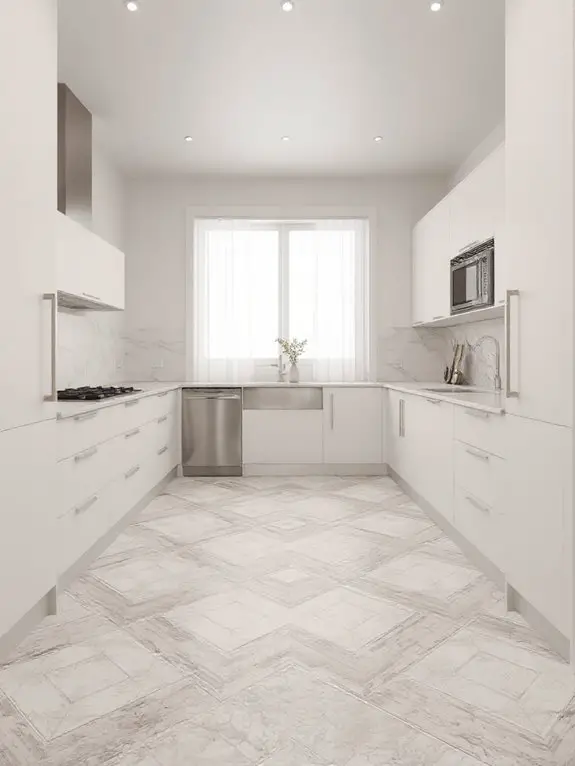
Patterned flooring instantly elevates a kitchen’s aesthetic, offering both visual interest and practical benefits like hiding minor wear. I’ve found that geometric tiles or encaustic cement designs create a bold statement, while subtle patterns like herringbone or chevron add sophistication without overwhelming the space.
Materials like ceramic, porcelain, or even luxury vinyl can achieve this look, depending on your budget and lifestyle. I recommend considering the overall color scheme to guarantee the pattern complements your kitchen’s design.
Additionally, patterned flooring can define zones in an open-plan layout, making it a functional choice. It’s a small change that makes a big impact.
Integrated Dining Nooks
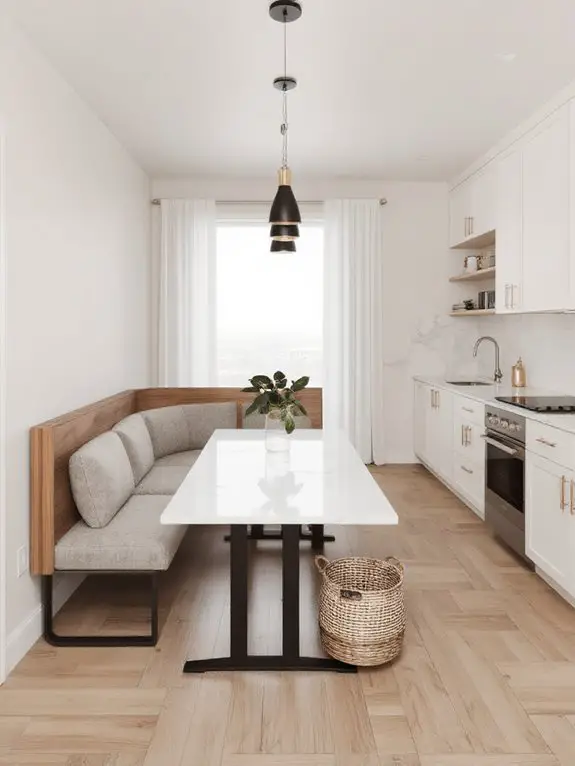
Integrated dining nooks offer a stylish and space-saving solution for smaller kitchens or open-plan layouts where every square foot matters. I love how they blend functionality with charm, creating a cozy spot for meals without sacrificing precious floor space.
Built-in benches with hidden storage maximize efficiency, while adding cushions and throw pillows can make the area feel inviting. Pairing the nook with a small table or extending a countertop creates a seamless look.
I often suggest using light colors or natural wood tones to keep the space feeling open. It’s a practical yet elegant way to enhance your kitchen’s usability and aesthetic.
Customized Pantry Designs
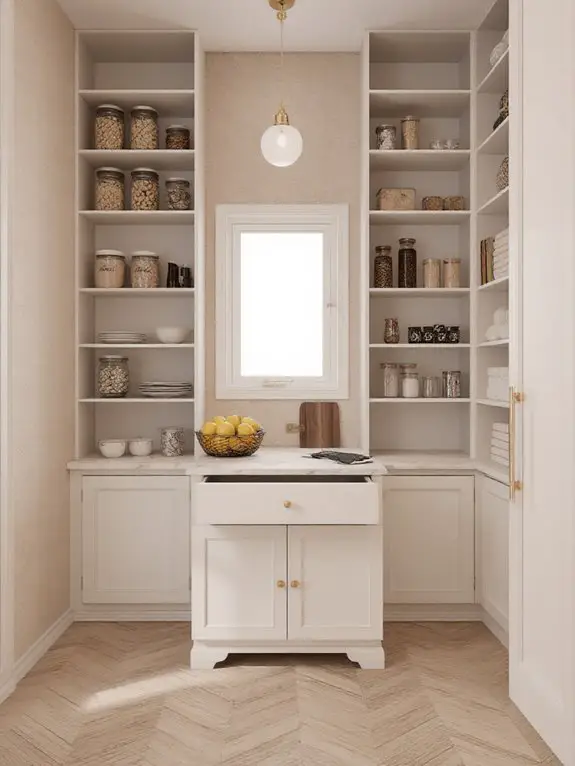
Just as integrated dining nooks optimize kitchen space, a well-designed pantry can transform how you store and access essentials. I’ve found that customizing a pantry to fit your specific needs makes a huge difference.
Start by evaluating what you store most—dry goods, spices, or appliances—and design shelves, drawers, or bins accordingly. Pull-out racks and tiered shelves maximize visibility and accessibility.
I recommend labeling containers and grouping items by category to streamline meal prep. If space allows, include a countertop for bulk packaging or baking prep.
A thoughtful layout not only saves time but also keeps your kitchen organized and efficient.
Eco-Friendly Materials
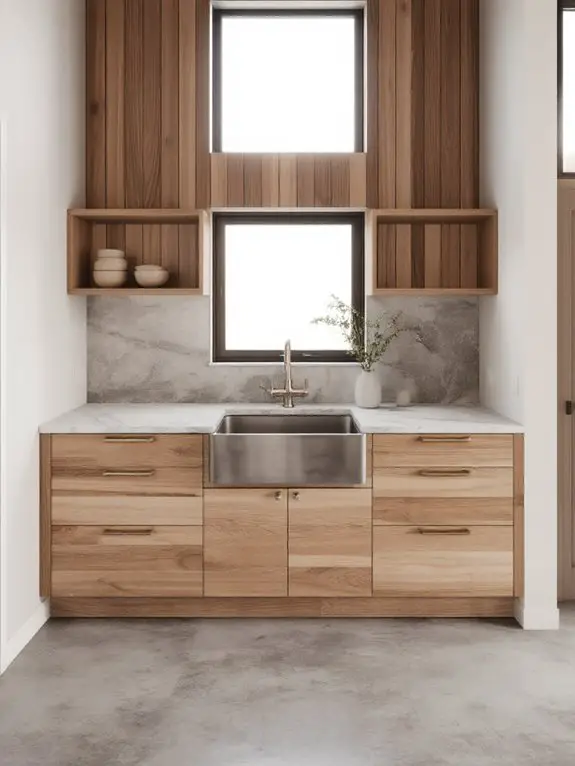
When planning a kitchen remodel, I always consider eco-friendly materials as a way to reduce environmental impact while creating a durable and stylish space. I opt for reclaimed wood for cabinetry or countertops, as it’s both sustainable and adds character.
Bamboo is another favorite—it’s renewable, durable, and works well for flooring or shelving. For countertops, I recommend recycled glass or quartz, which offer a sleek look while minimizing waste.
Low-VOC paints and finishes guarantee better air quality, and cork flooring is a great insulator. These choices not only protect the planet but also result in a kitchen that’s functional and timeless.
Ceiling Details
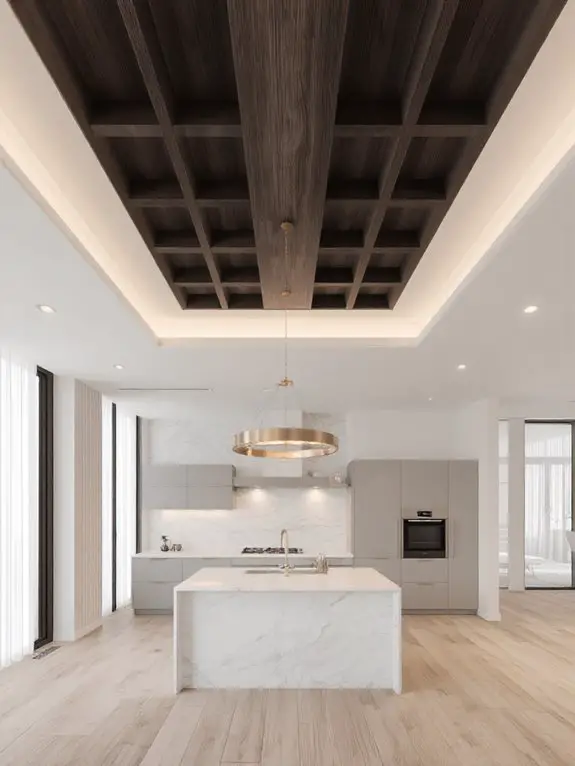
Why not consider the ceiling as the fifth wall in your kitchen design? Often overlooked, it’s a blank canvas waiting to elevate your space. I’d recommend painting it a bold color or using textured materials like wood planks or beadboard for added warmth. Exposed beams can create a rustic charm, while a glossy finish reflects light and makes the room feel larger.
If you’re feeling adventurous, try patterned wallpaper or metallic accents for a modern twist. Don’t forget lighting—pendant lights or recessed fixtures can highlight your design. It’s a subtle yet impactful way to transform your kitchen’s ambiance.
Glass Cabinet Doors
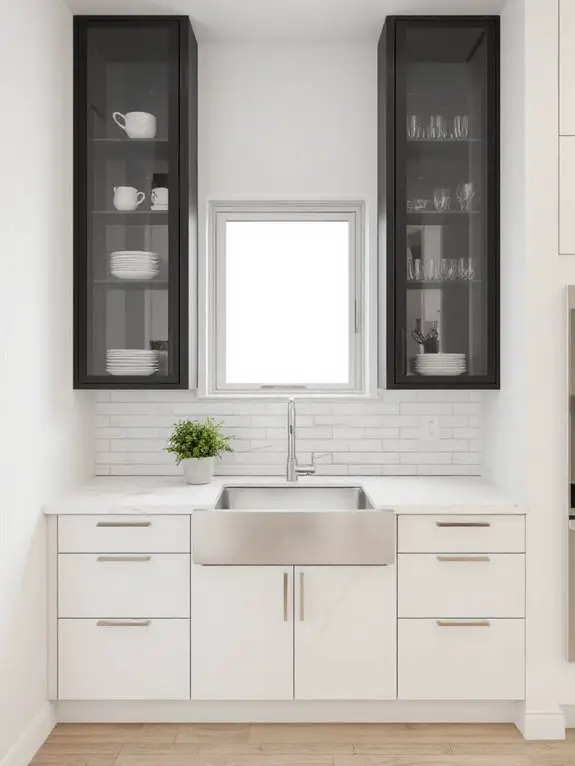
Although glass cabinet doors might seem like a purely decorative choice, they’re actually a practical way to enhance both the functionality and aesthetics of your kitchen.
I’ve found that they make it easier to locate items without opening every door, saving time and effort. They also create a sense of openness, especially in smaller kitchens, by reflecting light and making the space feel larger.
I recommend using tempered or laminated glass for durability and safety. Frosted or textured glass can hide clutter if you’re not keen on displaying everything.
It’s a simple upgrade that combines style and usability seamlessly.
Minimalist Hardware
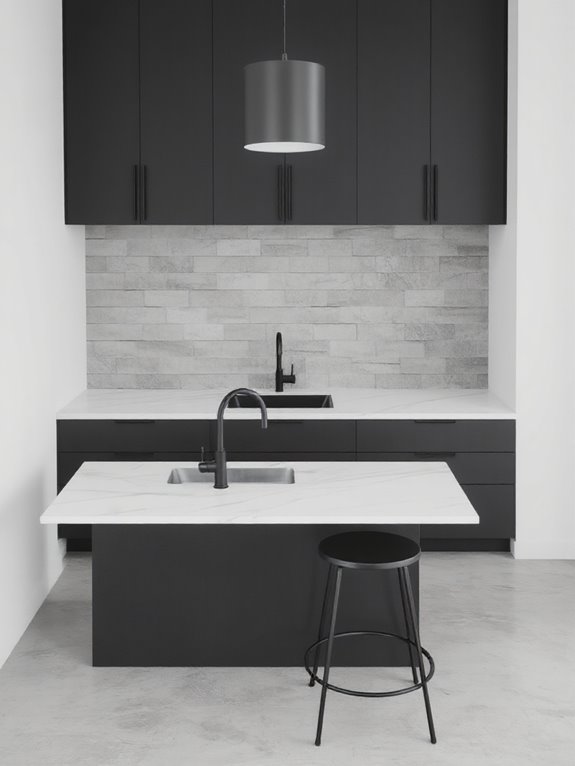
Choosing minimalist hardware for your kitchen can instantly modernize the space while offering a sleek, uncluttered aesthetic. I’ve found that streamlined handles or discreet knobs create a cohesive look, especially when paired with clean cabinetry.
Opting for materials like brushed nickel or matte black adds subtle sophistication without overwhelming the design. It’s also worth considering integrated or recessed hardware for a seamless appearance.
This approach not only enhances visual appeal but also simplifies cleaning—fewer crevices mean less dust accumulation. Minimalist hardware works particularly well in small kitchens, where it helps maximize the perception of space, making the area feel airier and more contemporary.
Textured Walls
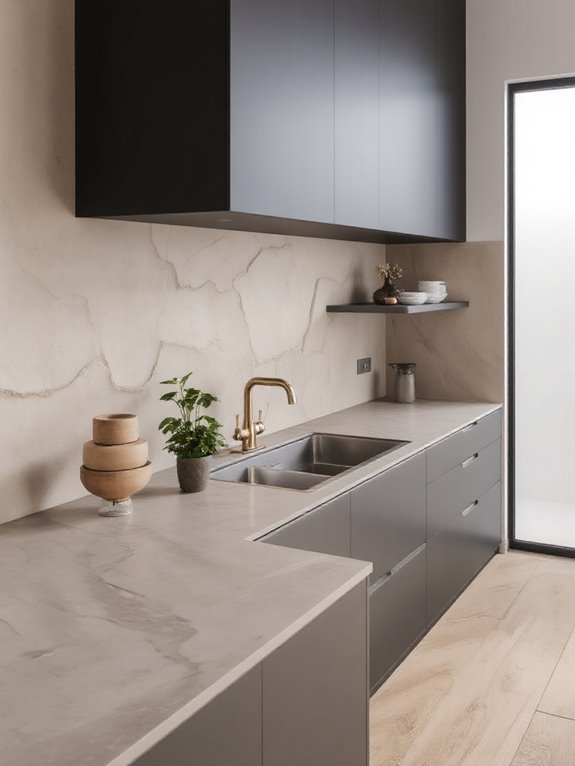
Textured walls can transform a kitchen from ordinary to extraordinary, adding depth and character without overwhelming the space. I’ve found that materials like plaster, reclaimed wood, or even textured tiles create a tactile experience that invites attention.
For a subtle effect, I recommend using textured paint or wallpaper on one accent wall. If you’re aiming for a bold statement, consider installing 3D panels or stone veneers.
Keep the color palette neutral to let the texture shine, or layer it with soft hues for a cohesive look. Remember, balance is key—pair textured walls with sleek countertops and cabinetry to avoid visual clutter.
Layered Lighting Schemes
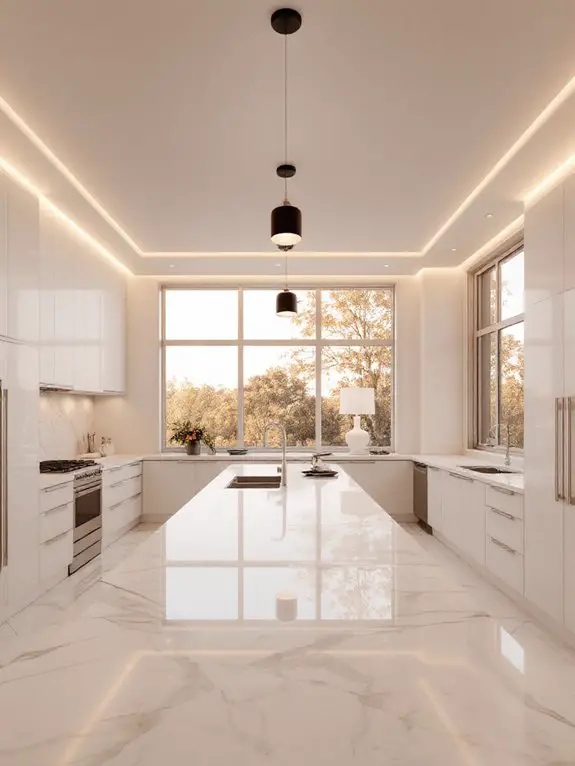
Layered lighting schemes elevate a kitchen’s functionality and ambiance by combining multiple light sources at different levels. I start with task lighting, like under-cabinet LEDs, to illuminate countertops for prep work.
Next, I add ambient lighting, such as pendant lights or a central fixture, to create a warm, inviting glow.
Finally, I incorporate accent lighting, like toe-kick LEDs or spotlights, to highlight architectural features or decor.
Dimmer switches are a must—they let me adjust the mood instantly. By blending these layers, I guarantee my kitchen isn’t just practical but also visually dynamic, adapting to any activity or time of day.
Industrial Elements
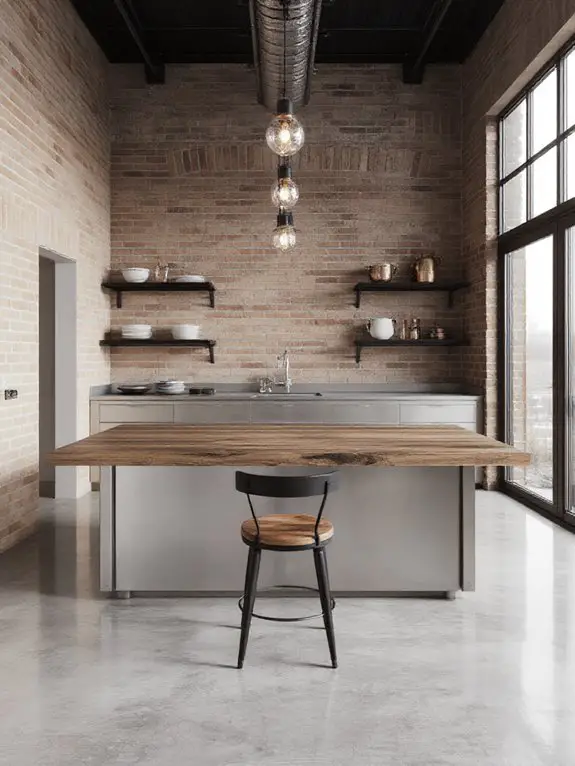
To infuse my kitchen with an industrial edge, I start by focusing on materials that exude raw, utilitarian charm. I opt for exposed brick walls, stainless steel countertops, and concrete flooring to create a rugged yet refined aesthetic. Metal accents, like brushed nickel hardware or iron light fixtures, add depth and texture.
I incorporate open ductwork or pipe-style shelving to emphasize the unfinished look. Reclaimed wood elements, such as a butcher block island, soften the space without losing its industrial vibe. Neutral tones like gray, black, and white keep the design cohesive, while pops of copper or rust add warmth and character.
Floating Shelves
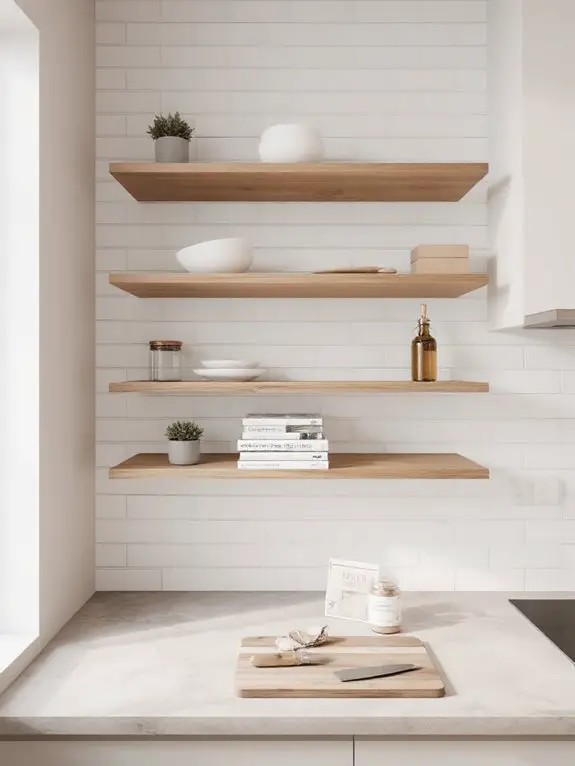
Incorporating industrial elements like exposed brick and metal accents sets a strong foundation, but floating shelves offer a sleek way to enhance both functionality and style. I’ve found that they create an open, airy feel, especially in smaller kitchens, while showcasing decorative items or essentials like spices and cookbooks.
Opt for materials like stained wood or matte metal to complement your design. Keep the arrangement simple—balance practical items with a few eye-catching pieces. I recommend keeping the spacing even and avoiding overcrowding to maintain a clean look.
Floating shelves are versatile, blending seamlessly into modern, rustic, or minimalist aesthetics effortlessly.
Bold Wallpaper Statements
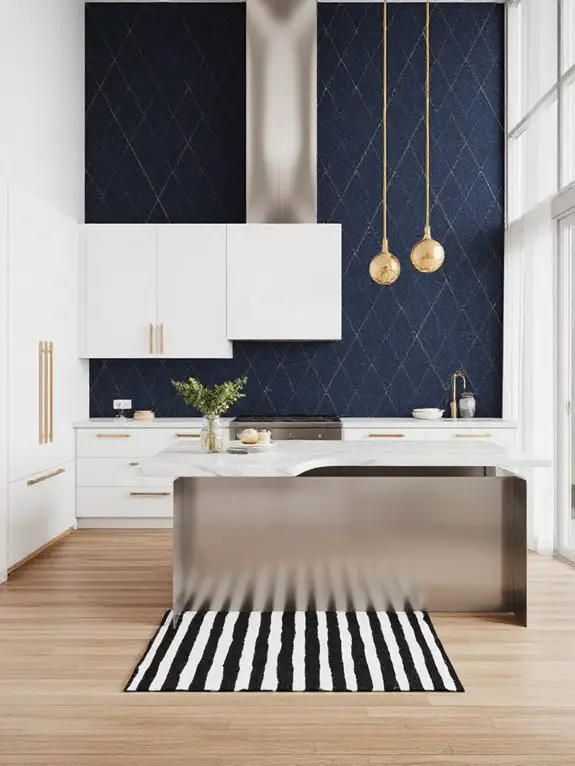
While it might seem unconventional for a kitchen, bold wallpaper can transform the space with personality and depth. I’ve found that choosing a design with rich colors or intricate patterns instantly elevates the room’s vibe.
Opt for moisture-resistant options to guarantee durability in a high-traffic area like the kitchen. I prefer using wallpaper on a single accent wall or behind open shelving to create a focal point without overwhelming the space.
Pairing bold patterns with neutral cabinets keeps the look balanced and modern. It’s a simple yet impactful way to infuse your kitchen with character and charm.
Multi-Functional Islands
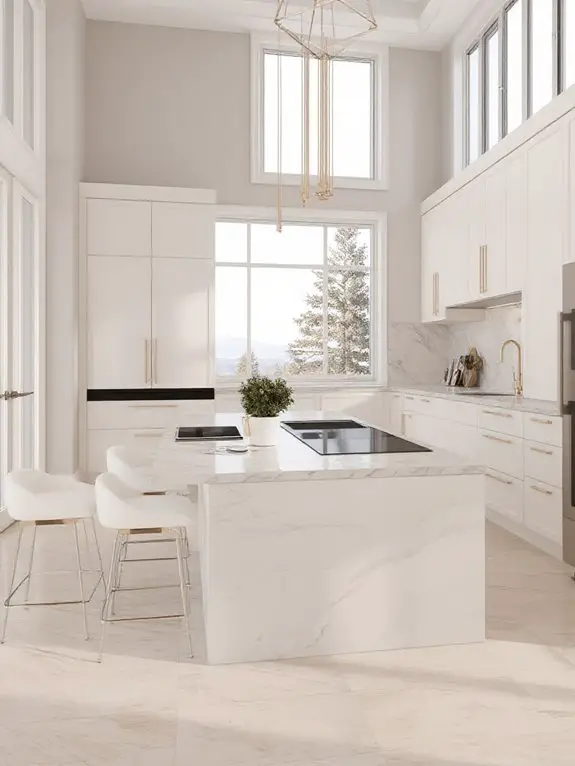
When designing a kitchen, multi-functional islands have become a cornerstone for maximizing both efficiency and style. I’ve found that incorporating seating, storage, and workspace into one central hub transforms the kitchen into a social and practical space.
I love adding built-in appliances like cooktops or sinks to streamline tasks, while drawers and shelves keep essentials organized. For smaller kitchens, I opt for movable islands that adapt to different needs.
Materials like quartz or stainless steel guarantee durability without compromising aesthetics. With thoughtful design, a multi-functional island becomes the heart of the kitchen, blending functionality with elegance in a way that enhances daily life.
Warm Wood Tones
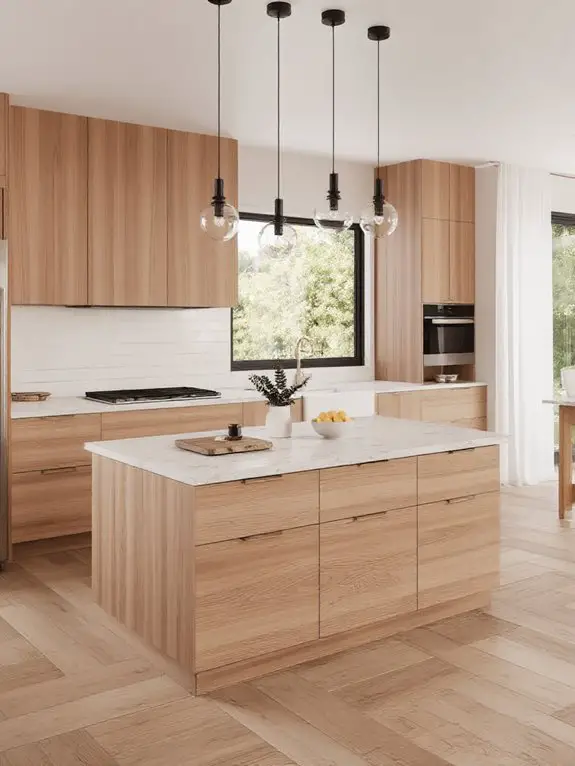
Though often overlooked, warm wood tones can dramatically elevate a kitchen’s ambiance by introducing natural warmth and timeless appeal. I’ve found that incorporating wood elements, like cabinetry, shelves, or even a butcher block countertop, creates a welcoming and organic feel.
Opt for rich shades like walnut or cherry to add depth, or go lighter with oak or maple for a brighter, airier space. Pairing wood with neutral tiles or metallic accents balances the look without overwhelming it.
Geometric Tile Patterns
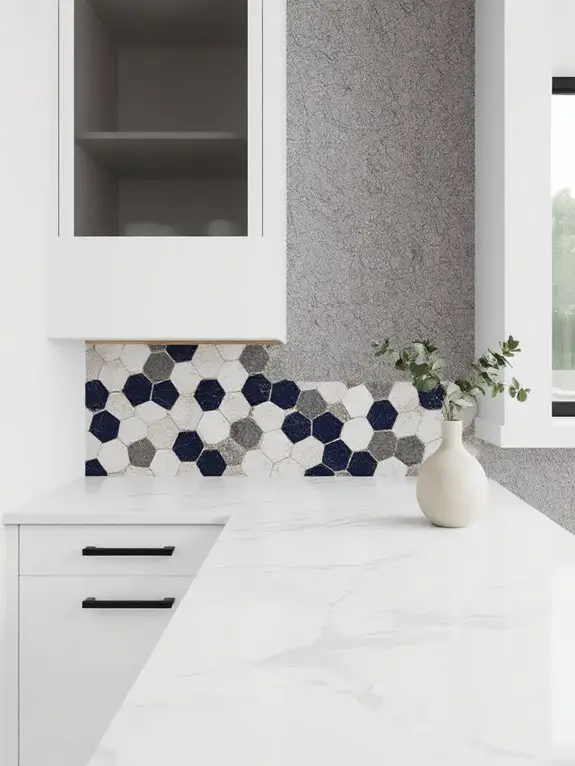
Geometric tile patterns offer a dynamic way to inject personality and visual interest into your kitchen design. I love how they can transform a simple backsplash or floor into a focal point, creating depth and movement.
Hexagons, chevrons, and herringbones are my go-to choices for modern spaces, while intricate Moroccan-inspired designs add a bold, artistic flair. I recommend sticking to a cohesive color palette to keep the look harmonious, especially in smaller kitchens.
Larger tiles with geometric motifs can make a space feel expansive, whereas smaller tiles work well for detailed patterns. Proper grout selection is key to enhancing the design’s impact.
Artful Styling Accents
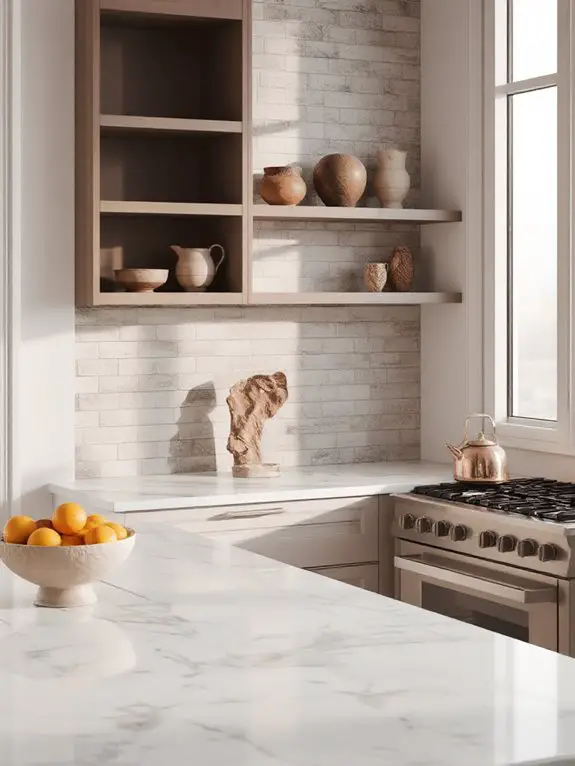
Artful styling accents can elevate your kitchen’s aesthetic by adding layers of texture, color, and personality. I love incorporating items like ceramic vases, woven baskets, or sculptural bowls to infuse warmth and character.
Think about displaying a curated set of cookbooks on open shelving or adding a statement piece like a vintage clock or artwork. Plants, whether fresh herbs or potted greens, bring life and vibrancy.
Don’t overlook functional accents like textured tea towels or handcrafted cutting boards—they’re practical yet stylish. By blending these elements thoughtfully, you’ll create a kitchen that feels both inviting and uniquely yours.
Frequently Asked Questions
What Is the Ideal Kitchen Layout for Small Spaces?
I’d go for a galley or L-shaped kitchen in small spaces to maximize efficiency. I’d use open shelving, compact appliances, and multifunctional furniture. I’d keep it clutter-free by prioritizing essentials and using vertical storage wisely.
How Do I Choose the Right Kitchen Ventilation System?
I’d consider my cooking habits first—if I fry often, I’d need a powerful range hood. I’d measure my space to confirm proper fit and check noise levels. Energy efficiency matters too, so I’d compare models carefully.
What Are the Best Ways to Organize Pots and Pans?
I’ve found that the best way to organize pots and pans is using deep drawers with dividers or stackable racks. Hanging them on a wall or ceiling rack also saves space and keeps everything within easy reach.
How Can I Maximize Natural Light in My Kitchen?
I’ll replace heavy curtains with sheer ones, install reflective backsplashes, and add mirrors to bounce light. I’ll keep windows clean, use light-colored countertops, and opt for open shelving to let natural light flow freely.
What Are the Latest Trends in Kitchen Sinks?
I’ve noticed deeper, single-basin sinks are trending—they’re great for large pots. Integrated drainboards save space, and matte black or brushed nickel finishes feel modern. I also love undermount sinks; they’re sleek and make cleanup a breeze.
